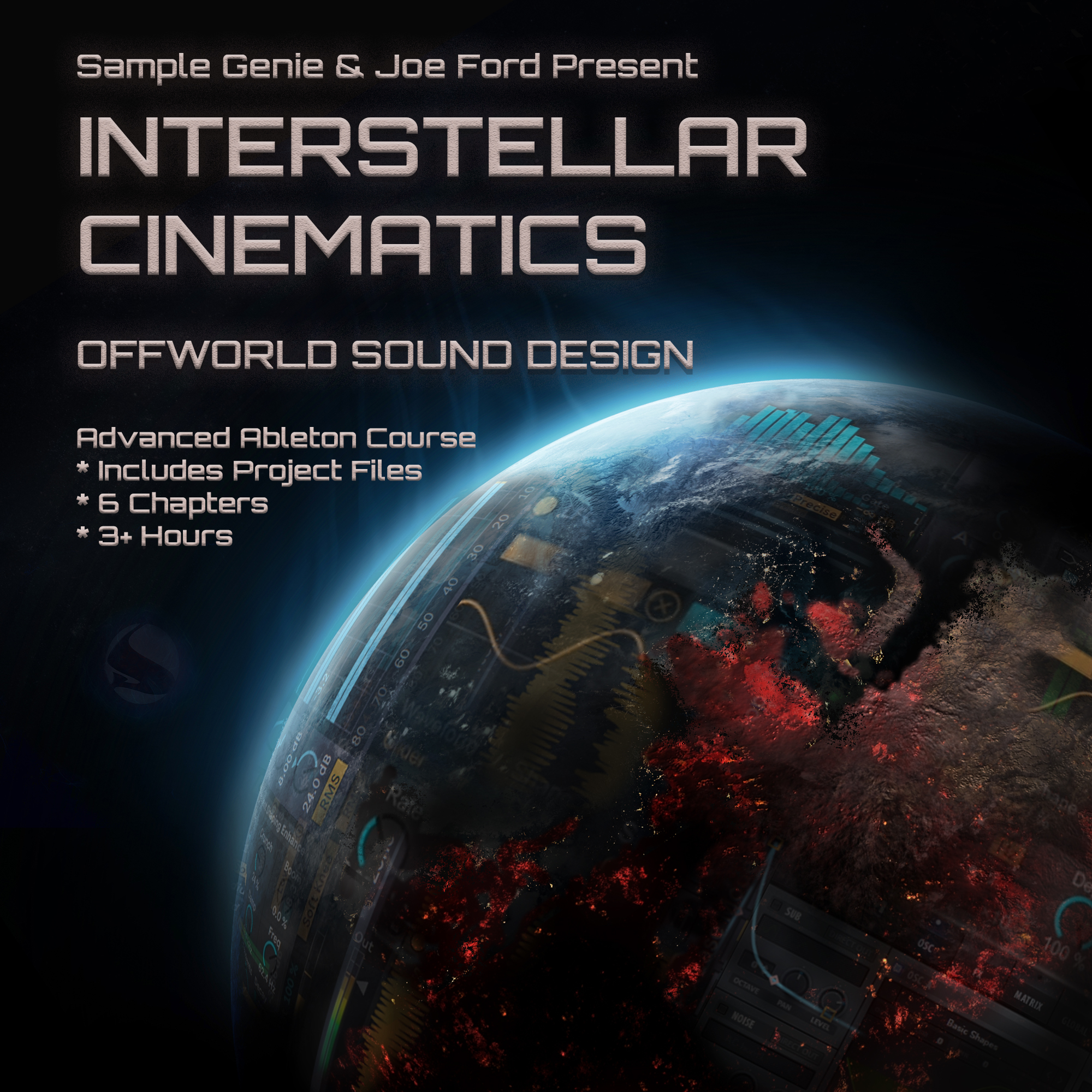Analysis of S6E05: Arkaik – Production & Workflow
- This topic has 4 replies, 4 voices, and was last updated 5 years, 8 months ago by ,
 GENIE HQ.
GENIE HQ.
-
AuthorPosts
-
-
2018-11-09 at 17:30:38 #57510,
 HarryModerator
HarryModeratorArkaik’s first tutorial ever, a deep dive in to his current production techniques & tools, broken in to four videos. Be sure to check out his Q&A as well: https://sample-genie.com/topic/arkaik-tutorial-qa-session/
Part 1 (28:08)
– Arkaik begins by going over his production history, how his focus is on clubs, prefers stripped back & minimal music as he finds “bashy amens & big reverb” do not sound good on club sound systems.
– “Minimal means maximum meaning, getting the most out of sounds”.01:55 – start of the studio view, using Logic X for his DAW.
02:30 – starts with a kick from a techno sample pack (Sumo? can’t find), likes to layer his kicks, sets to mono, states he is very sample based in his production.
03:15 – uses Logic’s Enveloper to tighten transient of the kick, and Logic’s EQ to adjust the kick’s sound.
04:30 – a wider kick layer is added, EQ’s out a lot of the low end of this sample, wants the mid of this kick, gives texture.
– Adds an Enveloper, also adds Logic’s Direction Mixer to add stereo width, and then a tiny amount of reverb with Valhalla Vintage Verb.
– At this point he is thinking about this drum layer’s use in the intro, using the reverb more for that section.08:25 – states he likes to use drums in a different way
– Creates a track with another copy of the mid kick layer, processes in a way to make it almost hi-hat like.
– Different EQ setting, uses Enveloper, different reverb settings, then adds Logic’s Bitcrusher, some more EQ to exaggerate the bitcrushing, and then another Directional Mixer.
– These techniques he finds helps gel his sounds together.12:05 – another instance of a kick processed to sound like a different hit.
12:50 – shows the Subsonic Labs Wolfram CM VST, a multi-effect unit that is included with Computer Music issue #187, used on the second modified kick.
– Link for CM 187 info: https://www.musicradar.com/news/tech/computer-music-187-february-2013-virtual-guitars-on-sale-now-56919414:10 – moving on to the snares section, likes rimshots over traditional snare hits.
– EQ’d to remove low end, has a +5.5dB boost at 345 Hz (close to an octave 4 key of F).
– Enveloper for transient hit, removed tail, sometimes doubles up the Enveloper inserts.15:50 – next snare, used for the top end.
– EQ and Enveloper to take out the initial attack, so the first snare is the main transient.18:45 – third snare layer is a variation of the second snare, with reverb added to it.
– Arkaik says this gives him the option to remove this one or the second snare occasionally.
– Thinks snare sound best with plate reverbs.22:00 – hats section, likes them short and snappy.
– Likes a peak at 10 Khz for drum & bass.
– Also likes hats soft sounding, sitting on the other drums.23:20 – adds Logic’s Ensemble VST to soften the hats, introduce some variation to the hats.
– More information on Ensemble: https://support.apple.com/kb/PH27453?locale=en_US&viewlocale=en_US25:45 – Foley sound of hitting trees with a stick, uses the nature reverb under the snares.
– Doesn’t want the initial hit.
– Likes these types of sounds to add some depth.—
Part 2 (37:52)
– Adding percussion elements to make Part 1’s drums more interesting, get more groove.02:00 – chopped up percussion loop with a few bits added to the loop.
03:40 – setting up busses to join the drum sounds together better.
– Kicks going to one bus, that then goes to a main drum bus. Wants to focus on how the kick sounds, then create busses for snares, hats, and percussion, with each going in to the main drum bus.07:15 – explains he does not want to bounce layers in to individual drums (e.g. three layers of snares bounced down in to one snare clip), as he wants to create variations, muting layer clips (e.g. snare layers 1 & 3, 1 & 2, 2 & 3, or just 1, 2, or 3).
07:45 – references QZB’s tutorial versus how he handles drum design; they are methodical, set gain staging each step of the way, while Arkaik just gets drums going, deals with levels later on.
08:30 – Camel Crusher VST to limit the snare bus.
09:35 – hats bus, but says he often just busses hats straight to the main drum bus.
11:15 – says he usually uses Ozone or Camel Crusher on main drum bus, for limiting.
13:00 – start of building sounds around the drums.
14:30 – creating variations of other drum sounds.
17:20 – using Logic’s Tremelo effect to create triplets out of percussion and reverbed sounds.
20:15 – explains way he likes this approach to resampling.
22:15 – if you pause the video at this point, you can see Arkaik has a small number of third party plug-ins, but they are mostly drum & bass producer standards.
25:00 – does a bounce of the snare, from the snare bus.
25:30 – using a reversed reverb in Logic’s Space Designer (a convolution reverb effect), 100% wet, to create new variations.
– More information on Space Designer: https://support.apple.com/kb/PH27798?locale=en_US&viewlocale=en_US32:15 – explains why he prefers minimal amounts of reverb, based on clubs and the natural reverb of those spaces reaching to the tracks played in them.
34:00 – thoughts on “minimal in maximum ways” and how this relates to sampled breaks, which were from the same drum kit or recorded in the same studio room.
36:30 – explains that he does not want big reverbed hits going to his drum bus, instead sends them to the main output of the DAW.
—
Part 3 (32:31)
– moving on to bussing and getting sounds working together.03:20 – looking at what was added since Part 2, added an extra kick that happens occasionally and is processed differently.
– This kick was made from the other two kick layers.04:25 – new snare layer added, made from the kick layers, pitched up +7 semitones.
06:45 – explains using Bitcrusher on snare bus, essentially making the snares 12-bit.
– Usually puts on drum bus but did not like how it sounded on the kick.08:00 – looking at the percussion section and “weird perc” bus.
10:00 – explains how he uses phasers on percussion.
– Might use the same phaser setting on several percussion tracks, finds it glues the sound together.12:45 – happy accidents make the best sounds.
14:45 – the hat bus.
16:30 – talks about drum sounds that he would send direct to the drum bus, rather than the sub-busses.
– Hats that he wants more defined, not as airy from reverb.18:30 – a shaker that is “behind” the main hat.
– Use of Tremelo to shape the sound.19:45 – the mid section, written in key of E.
21:00 – demonstrating how he turned a stab sample in to an atmosphere.
21:30 – white noise as tonal hiss to fill in frequency space of the drums.
22:30 – looking at Sonalksis Digital Grimebox VST, used for glitchy sounds.
– Also looks at Dadalife’s Endless Smile VST, often used for breakdowns.—
Part 4 (30:03)
– Looking at the bass, a one-shot sample loaded in to Logic’s EXS24 sampler.01:30 – bass goes to three busses, the first for the sub, which is sidechained to the kick.
03:45 – multiple busses of mids that feed in to one main mid bus.
07:00 – using Ensemble to create changing variations in the bass.
– A second section of bass with a different Ensemble setting.08:00 – explains all of the mid-bass elements.
13:00 – looking at mid-bass in the intro section.
17:00 – using the mids to glue together the drums.
18:15 – drum bus inserts, added Sonalksis Creative Filter to filter in & out sounds with automation.
19:30 – demonstrates using filter on drum bus to automate drums at the end of four bars.
20:10 – explains why he places Grimebox later in the effects chain, wants glitches to gel with the bass glitches.
– This is also demonstrated at the end of four bars.21:00 – answers technique question about glitchy drum edits.
– Gives control of whole of drums and whole of mids, where most of the track elements exist.23:00 – Ozone 7 on drum bus, using EQ module to cut low end (sub 30 Hz frequencies), and Maximizer module to limit the drums.
24:15 – looking at the final mix.
25:30 – Ozone 7 on the main bus, using EQ, Dynamics, Imager, and Maximizer modules.
– EQ with a slight boost to the low end, likes a bassy mix, then a dip in the high frequencies.
– Dynamics on multi-band mode, does not want snare to sound too compressed.
– Imaging with a tight band for low end, wide stereo width for high end.
– Maximizer as his final limiting on the track.28:30 – Arkaik wraps up by talking about what he thinks the track needs going forward.
– More elements and FX, made from different sounds rather than the existing elements.
– Arrangement needs progression, a second drop, and a section with new stab sounds.
– Says he would let this track sit for a couple weeks before coming back to it to finish it up.THOUGHTS & NOTES
– Arkaik is answering questions this month (November 2018) in this thread: https://sample-genie.com/topic/arkaik-tutorial-qa-session/
– I liked that he explained what minimal meant to him, and demonstrated his approach. Also his limited tool box of VSTs that he uses.
– I found the use of Ensemble and Tremelo interesting, as I’ve used this on other elements in the past.
– I might need to rewatch the last few minutes of parts 3 & 4, so this analysis might get updated later."Knowledge kept is knowledge lost." - Bobbito Garcia
-
2018-11-13 at 13:07:44 #57703,
 CYBiParticipant
CYBiParticipantany information about the sumo samplepack he used?
-
2018-11-15 at 08:25:45 #57805,
 GENIE HQKeymaster
GENIE HQKeymasterPerhaps the exact sample pack doesn’t matter too much… just the concept of using techno samples is what to take away from this lesson; rather than exactly which samples from which pack, used in the prescribed way.. Just use the principle and get creative 🙂
-
-
2018-11-13 at 14:36:25 #57707,
 HarryModerator
HarryModeratorany information about the sumo samplepack he used?
I couldn’t find it, and even tried searching based on the file names (fkb_).
"Knowledge kept is knowledge lost." - Bobbito Garcia
-
2018-11-14 at 09:04:26 #57739,
 BlackartParticipant
BlackartParticipantsomeone even asked him in the Q&A thread but i think he didn’t understand it’s a question…
subtle change make the big difference
-
-
AuthorPosts
- You must be logged in to reply to this topic.


